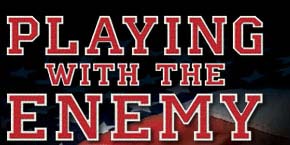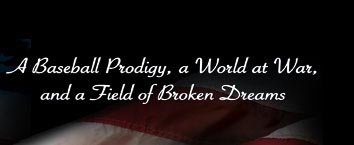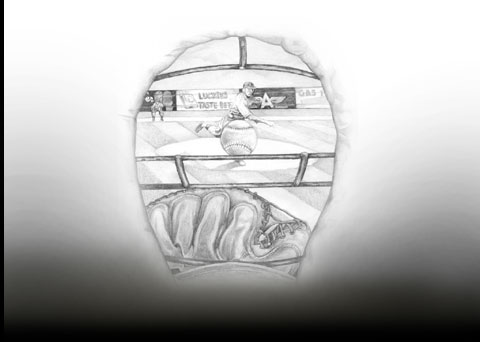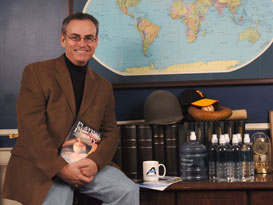|
SS: On its face, Playing with the Enemy is a baseball book, but it is so much more than that. How would you describe it to a stranger sitting next to you on an airplane?
GM: (Laughing). I have done that many times! Yes, it is a baseball story, a war tale, and much more. I like to think of it as a heartwarming story about baseball, WWII, destiny, character, family, and what a man does with a second chance. Playing with the Enemy is about a small town kid during the Great Depression. He is growing up in a dying coalmining town named Sesser, Illinois. This kid-my dad, Gene Moore-gave the people of Sesser hope for their future and faith in human nature because of his dream. Baseball and war are the backdrops for what I think is a very exciting and heartwarming story about life and what we choose to make of it.
SS: I agree. One thing that struck me was that the book is like a giant onion. As you peel it, each layer reveals something deeper, richer, fuller--something unexpected that really resonates inside . . .
GM: I love that description! And it is ironic you should say that, because I am getting email now-a lot of email-from people in and out of the media who have read the advance galley. Each of them shares with me their own personal experiences-baseball with their dad or son or grandfather or daughter, playing catch on a summer day, a career or fate that was not quite realized, emotional pain and resurrection and forgiveness. It seems to be resonating emotionally with people who read it, and I am deeply thankful for that.
SS: You mentioned playing catch with a daughter. Do you know yet how women are responding to the story?
GM: I do! I have had wonderful conversations with many women who have finished the book and love it. Just the other day a wonderful lady who edits two newspapers in California provided a really touching endorsement for us. Female readers tell me they learned a lot about baseball and the Second World War, but what really stuck them were the deep messages of family, love, honor, and all the ties that bind us together as humans. They really like the message-which I think is the book's foundation.
SS: Your description of Gene Moore on the first page of Playing with the Enemy captivated me. From that moment on, I was hooked on following Gene's life and his baseball career. It is an amazing story.
GM: Thank you. I wanted readers to discover the story of my father's life in the same way I experienced it. Growing up, I knew very little of my father's past. Only after I was an adult and my father had a heart attack scare did I learn about his remarkable life.
SS: For those who haven't yet read the book (which is not available for sale until September 15, 2006), can you describe Gene's life prior to WWII?
GM: He was true a baseball prodigy. From the time my father could walk the game fascinated him. He spent his happiest times playing baseball with the other boys and older men in Sesser on a field they nicknamed "The Lumberyard." Some of Gene's teammates were twice his age, but they didn't mind having Gene around because he was the best catcher, had the best arm, and the best bat. His talent didn't go unnoticed. The Brooklyn Dodgers discovered Gene and recruited him in 1940 when he was only fifteen years old, which in itself is an amazing fact.
SS: Yes, that's incredible! How did his life change when the United States entered the war?
GM: Gene, like millions of other Americans in his generation, answered the call of duty after Pearl Harbor. He didn't know at the time, but his baseball career would never be the same again. Dad played on the Navy's baseball team and entertained troops in the Azores and North Africa during the early part of the war. He was very patriotic, but his goal was to do his part, get through the war, and begin his Major League career. When the war moved onto the European continent, there was no time for baseball. Most of the teams were sent home. And then his life got really interesting . . .
SS: "I'll say. I am trying to ask the right questions, but not reveal too much of the story. What do you think was Gene's most memorable experience during the war?
GM: I believe there were two moving experiences. The first was when his team became part of the detail at Camp Ruston in Louisiana. He and the other Team Navy baseball players guarded the captured sailors from the U-505, a German submarine or U-boat. [Read more about this famous submarine in Savas Beatie's Hunt and Kill: U-505 and the U-Boat War in the Atlantic and Steel Boat, Iron Hearts: A U-boat Crewman's Life Aboard U-505.] Gene developed an understanding of his wartime enemy and taught part of the imprisoned crew how to play baseball to pass the time . . .
SS: Hence the name, Playing with the Enemy . . .
GM: Yes, exactly. My father was desperate to get back on the field and keep his own skills sharp, and he saw this as a way to do this, entertain the other guards, and pass the time.
SS: And the second experience?
GM: I would tell you about the second event, the one that turned out to be life altering, but I don't want to give away too much of the book. I think baseball author John Skipper says it best in his Introduction to Playing with the Enemy when he writes, 'Don't skip ahead. Read this like you would watch a movie,' or something like that. Let me just say this experience permanently changed the course of Gene's life and may have changed our national pastime. I know that after that period, my dad discovered the true meaning of life, love, and perseverance-but it took a long, long time.
SS: Speaking of the Introduction, baseball legend Jim Morris wrote the Foreword!
GM: Yes, it is a dream come true for me. "The Rookie" is one of my all-time favorite movies. My publisher, Ted Savas, had the idea of getting Jim to write something, and we tracked down Jim's agent, Steve Canter. Steve explained how busy Jim was, etc., but we sent the manuscript anyway. His agent called to tell us he loved it, and would pass it along to Jim. He really loved it, too, and generously provided a Foreword. I am truly grateful to both men for their help and support.
SS: You loved baseball as a kid, but your father seemed indifferent to the sport.
GM: I loved it. My dad didn't want me to play baseball at all-period. I had a natural love for the game early on and was pretty good at it, but Dad steered me into music. He would tell me that music was something I could enjoy the rest of my life and that baseball was not important. The truth is, baseball broke his heart and he wanted something different for me.
SS: When did you realize there was a lot in your father's past you were not aware of?
GM: My dad did not like to talk about his past. He was devastated by what he experienced, buried his memories deep inside himself, and only very occasionally opened that door. There were many demons lurking inside. Looking back, knowing what I know today, I remember moments from my childhood that indicated baseball was a huge part of my father's life. But that door shut quickly whenever I tried to walk through it.
SS: I found your recollections from your youth fascinating. Can you provide another example of a time when you realized there was more to your father's life than he let on?
GM: Sure. Whenever we visited my dad's hometown of Sesser, Illinois, I was always surprised at how my father was treated like a visiting dignitary. The townspeople-the older ones-would gather around him and talk about baseball games from the past for hours on end. I was just a kid of 10 or 12, so I did not listen that closely or try to remember the conversations word for word, but I remember the gist of them quite well. I did not understand it then-but I do now.
SS: How did you go about writing your father's story?
GM: The final conversation with my dad lasted many hours and opened the floodgates. In addition to my own memories and the letter from the Pittsburgh Pirates, I interviewed dozens of people who knew him, knew of him, played with him, watched him play, and so on. I conducted in-depth interviews with family members who witnessed it all. All of this helped me piece together the story of Gene's life. I also used a variety of written accounts including letters and service records. This story began with snippets of disjointed information that eventually came together to form the beautiful quilt that was Gene's life.
SS: You write in your Preface that there are some natural gaps in the research, that you did not have film footage or audio of your dad's life and so on. . . .
GM: Yes. My dad told me a lot of information, but he had talked with my mother about this secret nearly every day for three decades! They discussed the conversations, the experiences, the people, the places, how this felt, or how something happened. She knew the story by heart. But by this late date, some of the names had been forgotten, the records kept in the late 1930s and 1940s for instructional and minor league teams are next to non-existent. I had to piece together some things by implication, others by hunch, but I am confident I have captured Gene Moore's life in both spirit and experience.
SS: I was amazed at all the coincidences and connections between the characters. For example, the time when Gene's brother Ward rescued a fellow soldier from a crippled tank in Germany only to discover it was his friend from back home trapped inside! I have to ask, did that really happen?
GM: Yes, it did! I know it's hard to believe, but it's a true story that has been passed down for generations through my family and others who live in Sesser, Illinois. Like the story of Gene's career in baseball, it's one of Sesser's proudest memories! The book has so many stories like that.
SS: And we are more than pleased to be publishing your book, Gary.
GM: Well, if I may, let me say something about that. I am a history nut, and Savas Beatie truly is a premier publisher of outstanding historical works-I really mean that. We had other publishing options, but after several conversations with Ted Savas, I became convinced that Savas Beatie was the perfect home for Playing with the Enemy. He had a passion for the story and a passion for publishing, and I liked that. It was not just another book to him.
SS: I heard about how Ted surprised you with the illustrations interspersed throughout the book . . .
GM: (Laughing) They are absolutely amazing! Unbeknownst to me, Ted arranged for his friend and fellow baseball coach Val Laolagi to draw original period pencil art to visually depict some of the memorable moments from the book. They are truly stunning and really capture the feeling I have inside me-they really add something special to the book. I first saw some of the drawings when I opened a bound galley sitting in a hotel in Washington, D.C. Ted brought them with him. You were there, too, with our publicist, my wife Arlene, and my son Travis. The illustrations left me speechless and brought tears to my eyes-and I am not ashamed to say that.
SS: Me too!
GM: Let me also say that the last drawing in the book, which I only recently saw, captures my dad at 15 years old in his Sesser Egyptians uniform. When my sister saw it, she cried and said it looked just like my dad.
SS: The book goes on sale nationwide September 15, 2006. And you have quite a book tour planned!
GM: Yes, I can't wait! Southwest Airlines has graciously offered to sponsor our national book tour this fall. It kicks off in Chicago, Illinois, and continues throughout much of the fall. I will be traveling to cities around the country for media appearances, bookstore signings, and other speaking events. I wish I could start tomorrow!
SS: I also hear there is a major motion picture in the works for Playing with the Enemy.
GM: Yes, I am very pleased to announce that an academy award-winning producer has purchased the rights, a screenplay has been written, and they intend to go into production in 2007.
SS: Congratulations! Well, we look forward to receiving updates on your tour and the making of the Playing with the Enemy movie. Where can people go for more information?
GM: Anyone interested can read more about the book, the Fall tour and updates on the making of the movie on my website www.playingwiththeenemy.com.
SS: Can people write to you for additional information?
GM: Absolutely! I would love to hear from anyone interested in this story. They can email me at gmoore@playingwiththeenemy.com and go to the website to sign up for e-mail updates at www.playingwiththeenemy.com.
SS: One last question. What do you hope readers will gain from reading your book?
GM: I hope readers will come away realizing that in striving for a goal, what matters is who you become in the process, not what you get. Success is not a destination, but a journey. Dad's story is an example of how life does not always turn out as you plan, but there is more than one road you can travel and it is what we make of the journey that determines the value of our life.
SS: I know your father would be proud of how you tell his remarkable life story.
GM: I sure hope so. Thank you so much. It has truly been a labor of love.
(All copyright laws apply to this interview. However, this interview may be posted digitally on the internet or printed for use in newspapers, newsletters, magazines, and other similar uses, provided it appears in its entirety, and that notice of its use is provided in advance to sarahs@savasbeatie.com. We also allow partial edited use, with advance permission. Please inquire. Include our website www.savasbeatie.com and email address sales@savasbeatie.com with use. Thank you.)
|


 www.PlayingWithTheEnemy.com
www.PlayingWithTheEnemy.com







